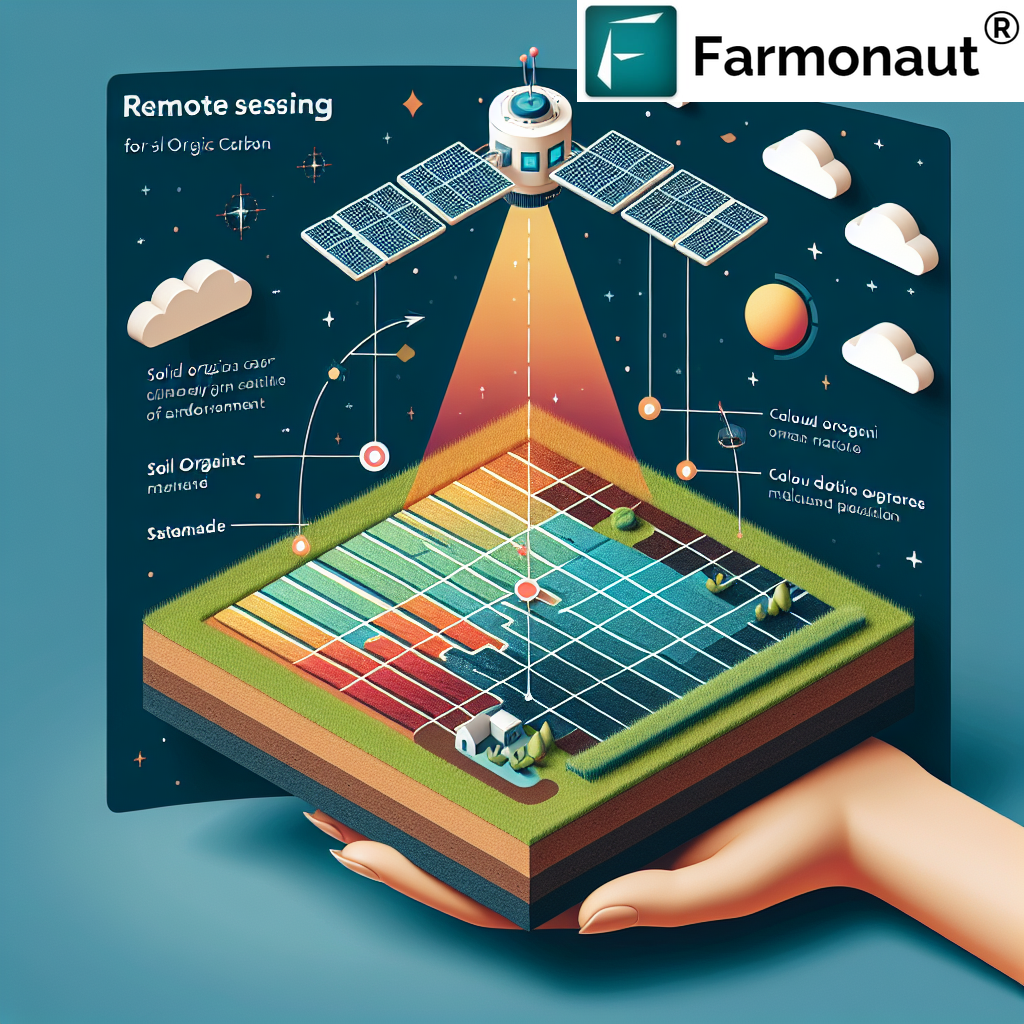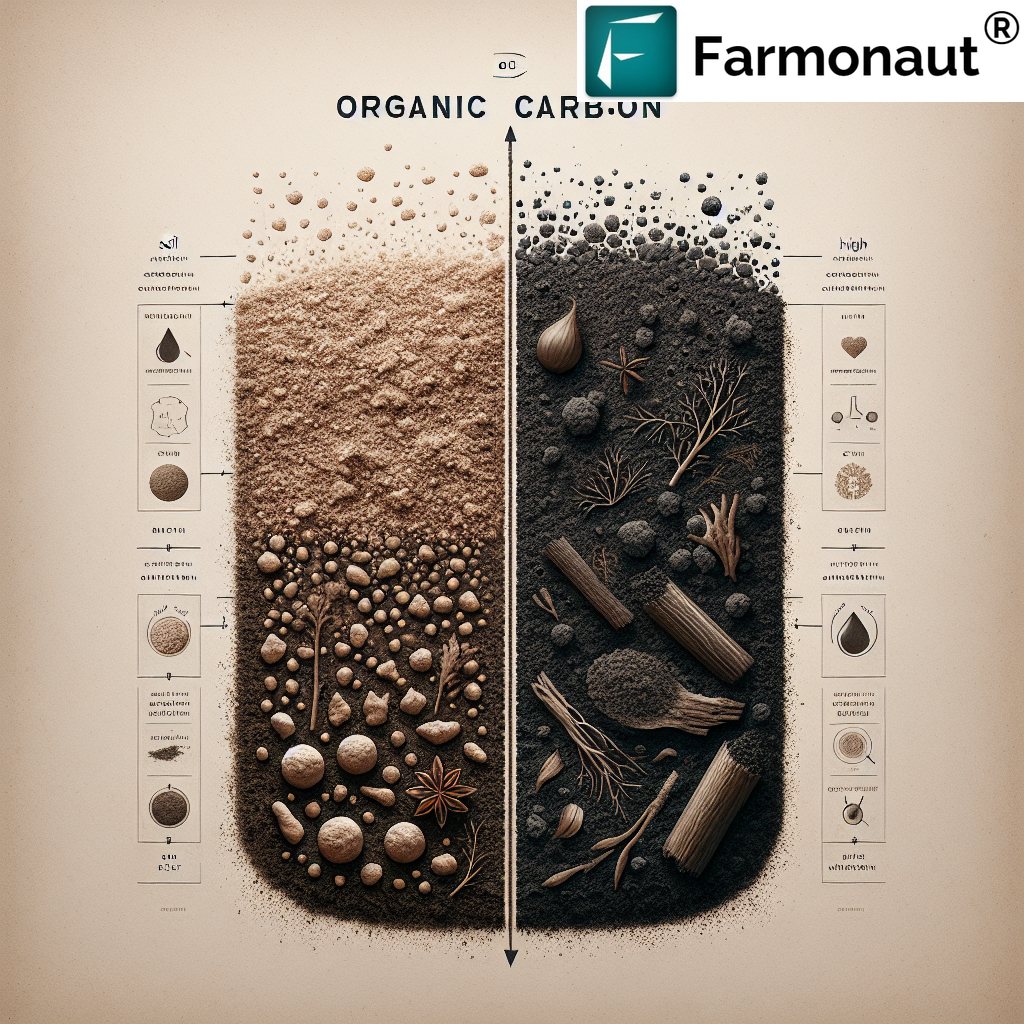Boosting Soil Health: Understanding and Improving Organic Carbon (OC) Content in Agricultural Soils

As pioneers in agricultural technology, we at Farmonaut understand the critical importance of soil health in sustainable farming practices. One of the key indicators of soil health is the organic carbon (OC) content. In this comprehensive guide, we’ll delve deep into the world of soil organic carbon, exploring its significance, measurement techniques, and strategies for improvement.
Table of Contents
- Introduction to Soil Organic Carbon
- The Importance of OC in Soil
- Measuring Soil OC Content
- Factors Affecting Soil OC Levels
- Strategies to Improve Soil OC
- The Role of Technology in Soil OC Management
- Case Studies and Success Stories
- Future Trends in Soil OC Research
- FAQs
1. Introduction to Soil Organic Carbon
Soil organic carbon (SOC) refers to the carbon component of organic compounds in soil. It’s a vital element of soil organic matter, which plays a crucial role in soil health, fertility, and overall ecosystem functioning. Understanding SOC in soil is fundamental to sustainable agriculture and environmental management.
What is Soil Organic Carbon?
Soil OC is derived from living organisms, plant residues, and other organic materials. It’s a complex mixture of carbon compounds, ranging from fresh plant residues to highly decomposed humus. The carbon in these compounds originates from atmospheric CO2 fixed by plants through photosynthesis.
2. The Importance of OC in Soil
The presence of organic carbon in soil contributes significantly to various soil functions and ecosystem services. Here’s why OC in soil is so crucial:
- Soil Structure: OC improves soil aggregation, enhancing soil structure and stability.
- Water Retention: Soils rich in OC can hold more water, reducing runoff and increasing drought resistance.
- Nutrient Cycling: OC is a primary source of nutrients for soil microorganisms and plants.
- Carbon Sequestration: Soils act as a carbon sink, helping mitigate climate change.
- Biodiversity: OC supports soil biodiversity, fostering a healthy soil ecosystem.
3. Measuring Soil OC Content
Accurately measuring soil OC is essential for effective soil management. Several methods are available:
Laboratory Methods
- Dry Combustion: The most accurate method, involving heating soil samples to high temperatures.
- Wet Oxidation: Uses chemical oxidation to measure OC content.
- Loss on Ignition: Estimates OC by measuring weight loss after burning soil samples.
Field Methods
- Spectroscopic Techniques: Near-infrared and mid-infrared spectroscopy for rapid, non-destructive analysis.
- Portable Carbon Analyzers: Handheld devices for quick field measurements.
Remote Sensing
At Farmonaut, we leverage advanced satellite technology to estimate soil OC content over large areas. Our satellite-based crop health monitoring system provides valuable insights into soil properties, including organic carbon levels. Learn more about our satellite-based solutions here.
4. Factors Affecting Soil OC Levels
Several factors influence the organic carbon content in soils:
- Climate: Temperature and precipitation affect OC decomposition rates.
- Soil Texture: Clay particles can protect OC from decomposition.
- Land Use: Agricultural practices significantly impact OC levels.
- Vegetation: Different plant types contribute varying amounts of organic matter.
- Topography: Slope and aspect influence soil moisture and OC accumulation.
5. Strategies to Improve Soil OC
Enhancing OC in soil is crucial for sustainable agriculture. Here are some effective strategies:
Conservation Tillage
Minimizing soil disturbance helps preserve existing OC and promotes accumulation.
Cover Cropping
Growing cover crops between main crop seasons adds organic matter to the soil.
Crop Rotation
Diverse crop rotations can increase OC inputs and improve soil structure.
Organic Amendments
Adding compost, manure, or biochar can significantly boost soil OC content.
Agroforestry
Integrating trees in agricultural landscapes enhances OC sequestration.

6. The Role of Technology in Soil OC Management
Modern technology plays a crucial role in managing and improving soil OC. At Farmonaut, we’re at the forefront of this technological revolution in agriculture.
Satellite-Based Monitoring
Our advanced satellite technology allows for large-scale monitoring of soil properties, including OC content. This enables farmers and researchers to track changes in soil health over time and across vast areas.
AI and Machine Learning
We employ sophisticated AI algorithms to analyze satellite data and provide actionable insights on soil health. Our Jeevn AI Advisory System offers personalized recommendations for improving soil OC based on real-time data.
Blockchain for Traceability
Our blockchain-based traceability solutions ensure that sustainable practices aimed at improving soil health can be verified and rewarded in the supply chain.
Farmonaut vs. Drone and IoT-Based Farm Monitoring
| Feature | Farmonaut Satellite System | Drone-Based Monitoring | IoT-Based Monitoring |
|---|---|---|---|
| Coverage Area | Large scale (Global) | Limited (Local) | Limited (Local) |
| Cost-Effectiveness | High | Medium | Low |
| Data Frequency | Regular (Every few days) | On-demand | Continuous |
| Ease of Use | Very High | Medium | Medium |
| Weather Independence | High | Low | Medium |
| Initial Setup Cost | Low | High | High |
For more information on our satellite-based solutions, visit our API documentation or download our app for Android or iOS.
7. Case Studies and Success Stories
While we don’t include specific case studies in this blog, it’s important to note that numerous farmers and agricultural organizations worldwide have successfully implemented strategies to improve soil OC. These success stories often involve a combination of conservation practices, technology adoption, and long-term commitment to soil health.
8. Future Trends in Soil OC Research
The field of soil organic carbon research is rapidly evolving. Some exciting future trends include:
- Precision Carbon Farming: Using high-resolution data to optimize carbon sequestration practices at the field level.
- Bioengineering for Enhanced Carbon Sequestration: Developing crop varieties with improved carbon fixation capabilities.
- Carbon Markets for Agriculture: Creating economic incentives for farmers to increase soil carbon stocks.
- Advanced Remote Sensing Techniques: Developing more accurate and detailed methods for measuring soil OC from space.
9. FAQs
Q: What is the ideal range of organic carbon in soil?
A: The ideal range of OC in soil varies depending on soil type and climate. Generally, a range of 2-5% is considered good for agricultural soils, with higher percentages being even better.
Q: How long does it take to increase soil organic carbon?
A: Increasing soil OC is a long-term process. Significant improvements can often be seen within 3-5 years of implementing good management practices, but substantial changes may take decades.
Q: Can increasing soil OC help combat climate change?
A: Yes, increasing OC in soil is an effective way to sequester carbon from the atmosphere, contributing to climate change mitigation.
Q: How does Farmonaut help in monitoring soil OC?
A: Farmonaut uses advanced satellite technology and AI algorithms to provide insights into soil health, including estimates of organic carbon content. Our technology allows for large-scale, cost-effective monitoring of soil properties.
Q: Are there any quick ways to boost soil OC?
A: While there are no “quick fixes,” adding organic amendments like compost or biochar can provide a relatively rapid boost to soil OC. However, long-term management practices are crucial for sustained improvement.
Understanding and managing soil OC is crucial for sustainable agriculture and environmental health. At Farmonaut, we’re committed to providing farmers with the tools and insights they need to optimize their soil health and productivity. Our satellite-based technology offers a cost-effective, large-scale solution for monitoring and improving soil organic carbon levels.
To learn more about how Farmonaut can help you manage your soil health, including organic carbon content, visit our developer documentation or subscribe to our services:
By leveraging our advanced technology and your dedication to soil health, together we can create more sustainable and productive agricultural systems for the future.